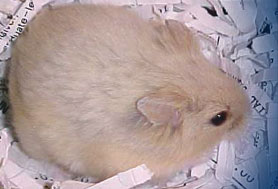

Dwarf Hamster Care
Basic Care: Handling
| Housing | Bedding | Nesting Material | Cleaning | Exercise | Teeth | Food | Costs | Handling |
Advanced Care:
| Things to Consider | Gender | Pairing | Housing | Baby Care | Campbells Dwarf Hamster Genetics
|
Need to tame a litter of baby dwarfs? Find information on how I tame my babies on this page: socializing baby dwarf hamsters |
Tips for handling all dwarf hamsters:
|
HandlingCampbells Russian Dwarf Hamsters have a reputation for being nippy and somewhat aggressive. This reputation is not totally warranted as dwarfs are very capable of being sweet and good natured. I have seen and made the mistake of purchasing a few dwarfs that bit me before I left the store with them. While it is possible that a dwarf may nip out of fear if suddenly grabbed, there is no reason one should bite if just being gently held. However, due to inbreeding and a desire for fancier colors and higher production rates some petstore suppliers may not care if the hamsters are good natured as they will make their money either way. (Disclaimer: This is my opinion not fact. It just seems likely as my effort to breed sweet natured dwarf hamsters without genetic problems and aggression has been successful and few aggressive babies are now born into my hamstery). Why bring up aggression at all? The reason is this: there are alot of cage aggressive dwarf hamsters out there. Cage aggressive means that a hamster will attack or bite while in his or her cage. It is really better to have patience and buy a dwarf hamster that does not bite. If people stop buying the aggressive ones, maybe the suppliers will get the hint and work on producing nicer animals. Not all hamsters sold in petstores are aggressive but I have come across quite a few. Believe it or not, many aggressive dwarf hamsters that bite in their cages are well-behaved once they are outside of them. However, getting them out can be a challenge as it really is not very fun to get bit! Here are a few methods to take out an aggressive hamster:
All pictures on this site are copyrighted by Odds and Endlers. Any unauthorized use is strictly prohibited. |
|
